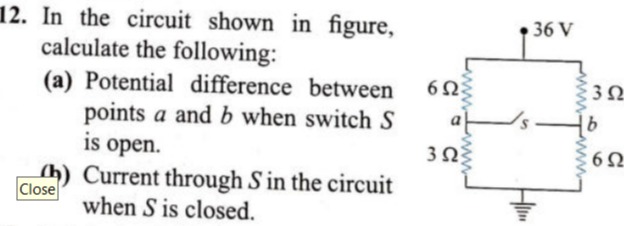Question
Question: In the circuit shown in figure, calculate the following: (a) Potential difference between points a ...
In the circuit shown in figure, calculate the following:
(a) Potential difference between points a and b when switch S is open.
(b) Current through S in the circuit when S is closed.

(a) -12 V, (b) 3 A (flowing from b to a)
Solution
(a) When the switch S is open, points 'a' and 'b' are disconnected. The circuit consists of two independent voltage dividers. For point 'a': The potential at point 'a' (Va) is calculated using the voltage divider rule: Va=36V×6Ω+3Ω3Ω=12V For point 'b': The potential at point 'b' (Vb) is calculated using the voltage divider rule: Vb=36V×3Ω+6Ω6Ω=24V The potential difference between points 'a' and 'b' is Vab=Va−Vb=12V−24V=−12V.
(b) When the switch S is closed, points 'a' and 'b' are connected, meaning Va=Vb. Let this common potential be Vx. Applying Kirchhoff's Current Law (KCL) at the node Vx: 636−Vx+336−Vx=3Vx+6Vx Multiplying by 6: (36−Vx)+2(36−Vx)=2Vx+Vx 108−3Vx=3Vx 108=6Vx Vx=18V Now, find the current through the switch S. Let Ia→b be the current flowing from 'a' to 'b' through the switch. Applying KCL at node 'a': 636−Va=3Va+Ia→b 3A=6A+Ia→b Ia→b=3A−6A=−3A The negative sign indicates that the current flows from 'b' to 'a' with a magnitude of 3A.
